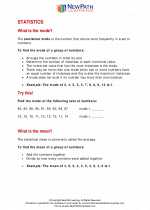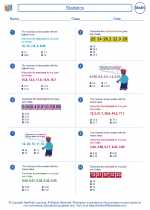Divide: Explanation and Study Guide
When we divide numbers, we are essentially breaking a quantity into smaller, equal parts. For example, if we have 10 candies and we want to share them equally among 2 friends, we would divide 10 by 2 to find out how many candies each friend gets.
Here are the key terms and concepts related to division:
- Dividend: This is the number that is being divided. In the example above, 10 is the dividend.
- Divisor: This is the number by which the dividend is being divided. In the example above, 2 is the divisor.
- Quotient: This is the result of the division. In the example above, the quotient is 5, meaning each friend gets 5 candies.
- Remainder: Sometimes, after dividing, there may be a number left over. This is called the remainder. For example, if we divide 10 by 3, the quotient is 3 with a remainder of 1.
Here are some important tips for division:
- When dividing, it's important to remember that division is the opposite of multiplication. If 3 x 4 = 12, then 12 ÷ 4 = 3.
- If the dividend is smaller than the divisor, the quotient will be 0 with the dividend as the remainder.
- Long division is a common method for dividing large numbers. It involves breaking down the division into smaller steps and is particularly useful for dividing numbers with multiple digits.
Now that we understand the basics of division, let's practice with some examples!
Practice Questions
- Divide 24 by 6.
- Find the quotient and remainder when 35 is divided by 8.
- Use long division to divide 187 by 11.
After practicing these questions, you'll have a better understanding of division and be ready to tackle more complex problems!
[Divide] Related Worksheets and Study Guides:
.◂Math Worksheets and Study Guides Fifth Grade. Statistics
Study Guide Statistics
Statistics  Worksheet/Answer key
Worksheet/Answer key Statistics
Statistics  Worksheet/Answer key
Worksheet/Answer key Statistics
Statistics  Worksheet/Answer key
Worksheet/Answer key Statistics
Statistics 

 Worksheet/Answer key
Worksheet/Answer key
 Worksheet/Answer key
Worksheet/Answer key
 Worksheet/Answer key
Worksheet/Answer key

The resources above cover the following skills:
Data Analysis and Probability (NCTM)
Select and use appropriate statistical methods to analyze data.
Use measures of center, focusing on the median, and understand what each does and does not indicate about the data set.